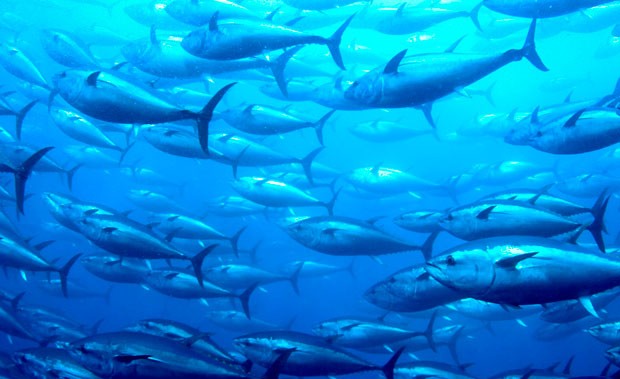Once mercury gets into the marine food chain, mostly from human industrial sources such as coal-fired electricity generation, smelting and the incineration of waste, it “bioaccumulates” in the larger ocean predators. That’s why larger fish — like the bluefin tuna pictured here — are generally riskier to eat than smaller ones. Credit: iStock/Thinkstock
Dear EarthTalk: I know that large fish contain a lot of mercury, but where does it come from? And what are we doing to prevent this contamination?
— Alison Bronner, Atlanta, GA
Mercury in the fish we like to eat is a big problem in the United States and increasingly around the world. Mercury itself is a naturally occurring element that is present throughout the environment and in plants and animals. But human industrial activity (such as coal-fired electricity generation, smelting and the incineration of waste) ratchets up the amount of airborne mercury which eventually finds its way into lakes, rivers and the ocean, where it is gobbled up by unsuspecting fish and other marine life.
Once this mercury gets into the marine food chain, it “bioaccumulates” in the larger predators. That’s why larger fish are generally riskier to eat than smaller ones. Those of us who eat too much mercury-laden fish can suffer from a range of health maladies including reproductive troubles and nervous system disorders. The U.S. Environmental Protection Agency (EPA) reports that human fetuses exposed to mercury before birth “may be at an increased risk of poor performance on neurobehavioral tasks, such as those measuring attention, fine motor function, language skills, visual-spatial abilities and verbal memory.” Up to 10 percent of American women of childbearing age carry enough mercury in their bloodstreams to put their developing children at increased risk for developmental problems.
In partnership with the U.S. Food and Drug Administration, the EPA issues determinations periodically in regard to how much mercury is safe for consumers to ingest from eating fish. State and tribal environmental authorities and/or health departments issue fish consumption advisories for water bodies in their respective jurisdictions based on federal guidelines. The EPA consolidates these local and regional advisories on its website, where concerned consumers and fisher folk can click on a map of the states to find out which advisories may be in effect in their area.
As for which fish to avoid, the non-profit Environmental Defense Fund (EDF), which runs the handy Seafood Selector website, reports that people with mercury concerns should steer clear of bluefin tuna, walleye, king mackerel and marlin. Bluefish, shark, swordfish, wild sturgeon, opah and bigeye tuna carry a proportionately large mercury burden as well. Also of concern, but to a slightly lesser extent, are orange roughy, Chilean sea bass, blue crab, lingcod, Spanish mackerel, spotted seatrout, wahoo, grouper, snapper, halibut, tile fish, rock fish and sable fish, as well as blackfin, albacore and yellowfin tuna.
Beyond what individuals can do to avoid mercury, the U.S. government and states have begun working together to reduce mercury emissions from power plants. Earlier this year the EPA proposed new “Mercury and Air Toxics Standards” regulating mercury emissions from utilities across the country, with the goal of reducing the amount of mercury emitted by coal burning by 91 percent by 2016. Elsewhere, representatives from 140 countries signed on to reduce global mercury pollution at a 2009 United Nations Environment Program’s Governing Council meeting in Nairobi, Kenya. The agreement commits signatory countries—including the U.S.—to cutting back on the use and emission of mercury. A legally binding treaty mandating just how much each country will have to cut back mercury emissions takes hold in 2013.
CONTACTS: EPA Mercury and Air Toxics Standards, www.epa.gov/airquality/powerplanttoxics/; EDF Seafood Selector, apps.edf.org/page.cfm?tagID=1521.
EarthTalk® is written and edited by Roddy Scheer and Doug Moss and is a registered trademark of E – The Environmental Magazine (www.emagazine.com). Send questions to: [email protected]. Subscribe: www.emagazine.com/subscribe. Free Trial Issue: www.emagazine.com/trial.








